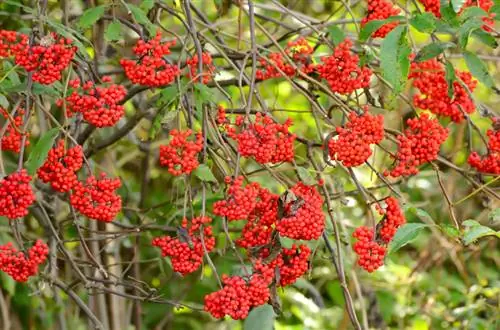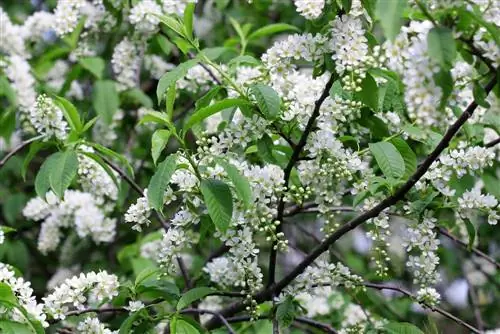- Author admin [email protected].
- Public 2023-12-16 16:46.
- Last modified 2025-06-01 06:02.
It does not reach the enormous dimensions of a black elderberry. Of course, that doesn't mean that a grape elderberry should hide behind it. Explore the attractive attributes of the decorative wild fruit tree and care aspects worth knowing here.

How do I care for a grape elderberry?
The grape elderberry (Sambucus racemosa) is an undemanding wild fruit tree that reaches a height of up to 4 meters. Its white flowers appear in May and June, followed by scarlet berries from August. Care includes regular fertilization, occasional watering and pruning every 1-2 years.
Natural beauty in numbers
Grape elderberry impresses with a white floral pattern in May and June, which is followed by a scarlet berry covering from August onwards. This means that it can be clearly distinguished from its powerful relative even from a distance. Instead of competing with it, grape elderberry scores points with its casual coolness in an individual way. The following profile conveys exactly what characteristics are hidden behind it:
- Growth height up to 400 centimeters
- Growth width up to 300 centimeters
- annual growth: 20 to 50 centimeters
- bronze-colored shoots in March/April
- dull green pinnate leaves
- cone-shaped, white inflorescence
- golden yellow foliage color in autumn
The bright red elderberries are only suitable for consumption with considerable effort. In contrast to black elderberries, they do not lose their toxic content when cooked. Before that, the small kernels have to be removed, a hard, undesirable job. Therefore, environmentally conscious hobby gardeners leave the red fruits on the elderberry, much to the delight of more than 60 species of birds.
Sympathetic personality - undemanding care
When choosing a location, a grape elderberry does not create any gardening hurdles. The wild fruit tree thrives in all places with sunny to partially shaded lighting conditions. The shallow-rooted plant makes little demands on soil conditions. There should be a minimum amount of humus and there should be no permanent dryness or waterlogging. Nursing attention is limited to the following work:
- As part of planting, enrich the soil with compost (€43.00 on Amazon) and horn shavings
- fertilize from March to August with compost or alternative organic fertilizers
- Alternatively, administer a slow-release fertilizer in spring and summer
- Water elderberry thoroughly during prolonged dry periods
- prune every 1-2 years between November and March
If there is a threat of frost in winter, water the shrub on frost-free days. Cold frost always occurs when the snow cannot be seen in permanent frost. The plants lack moisture from above, while at the same time the roots in the frozen ground cannot access water. Drought stress leads to the death of trees much more often in winter than during the warm season.
Tips & Tricks
Grape elderberry is popularly known by a variety of names. Don't be confused, because this species is also known as mountain elder, red elder and deer elder. If you want to be on the safe side when purchasing young plants or seeds, ask for a Sambucus racemosa.






